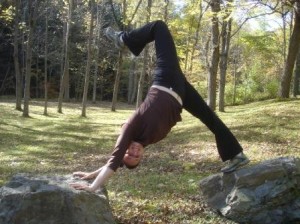Writing yesterday about the science of stretching made me realize I have more to write about on a personal level. For the past 4-5 months, I’ve been “aware” of my left hamstring, right at the origin where the hamstring connects to the sit bone (so, think at the bottom of the buttocks/top of the thigh).
I am extremely flexible – partially, just naturally – and definitely because of a sustained yoga practice for the last 16 years. I’ve never had a yoga injury, really never had any kind of an injury.
Except that I got hit by a car 8 years ago. I was walking in the crosswalk and the damn car hit me! Thankfully, he’d started to slow down, so I wasn’t seriously injured (though, I’m still angry at bad drivers when I’m walking – my “pedestrian rage” is a post for another time though).
At the time of the accident, I didn’t go for treatment – there was nothing really wrong. But over the weeks, I realized my back was sore and it wasn’t going away. After a visit to my regular doctor (useless), lots of chiropractic (marginally helpful), and lots of massage and yoga (tremendously helpful), I was back to normal. Except I could feel a bump on the right sacro-iliac joint – scar tissue that had formed. The bump is still there to this day.
For years, I had no problem. But then I started running, and I kind of overdid it. I did too much too fast (very common when people discover something new and challenging). For the first time in 4 years, I felt my back again. I was surprised – I didn’t think I had anything still in there. I stopped running and it went away. I started running again 6 months later – it came back. This time I’d also just ended a long-term romance and that really seemed to compound the situation. It took longer to sort out my back, and more treatment from bodyworkers. I stopped doing backbends during this period of time, which in retrospect, was a mistake.
Over the 4 years since these recurrences, I’ve felt my back off and on. A flare-up always happened if I got overzealous in physical exercise, or if I had an emotional stress in my life. It’s very interesting. I’ve learned that my back is awesome and strong, and it also tells me what I need to know. And I’ve been lucky that on the painscale, all of this has been pretty minor. I haven’t ever been laid-up in bed, unable to teach or in a lot of pain.
The hamstring is a new manifestation of this old injury. It’s been telling me I’ve been overdoing certain parts of my yoga practice (leg stretches like triangle and straddle – things that typically feel really good) and underdoing other parts (leg strengthening, back bending). Also, a big thing is that I’ve been demonstrating postures too haphazardly in class – just popping into a triangle as I’m talking about a certain aspect of the posture, for example.
I’m consciously learning that I have to use other people to demonstrate. I teach 15 sessions a week – it’s very demanding on my body, and I have to recognize that if this hamstring is going to stop nagging me, I’ve got to let it be when I teach. I’m also realizing that it might help to “admit” this to students in class. It’s hard, because it doesn’t really “hurt.” I’m not really “injured.” I want to demonstrate postures, because it makes it easier to teach. I don’t want to talk about myself, because class is for the students, not for the teacher. But I think I need to treat this as if I am injured, and be honest in order to model how to work with your limits in yoga practice. Otherwise, it feels clear that it’s only going to get worse, not better.
I’ve gotten some good chiropractic to adjust my pelvis. I continue to get massage on it, and self massage (more on this in a later post). I’m working on changing my own practice. Now you can help me by not letting me overdo it in class 🙂
This has gotten long, so I’ll write more in a future post about what I’m doing to help this injury. Lots of you have hamstring or other issues, and I’d like to write more about how to develop a therapeutic yoga session.
Thanks everyone, for helping me with this latest “inquiry” into the power of yoga and the beauty of our body’s messages. Even when they’re messages we’d rather not hear 🙂
Namaste,
Barrett
